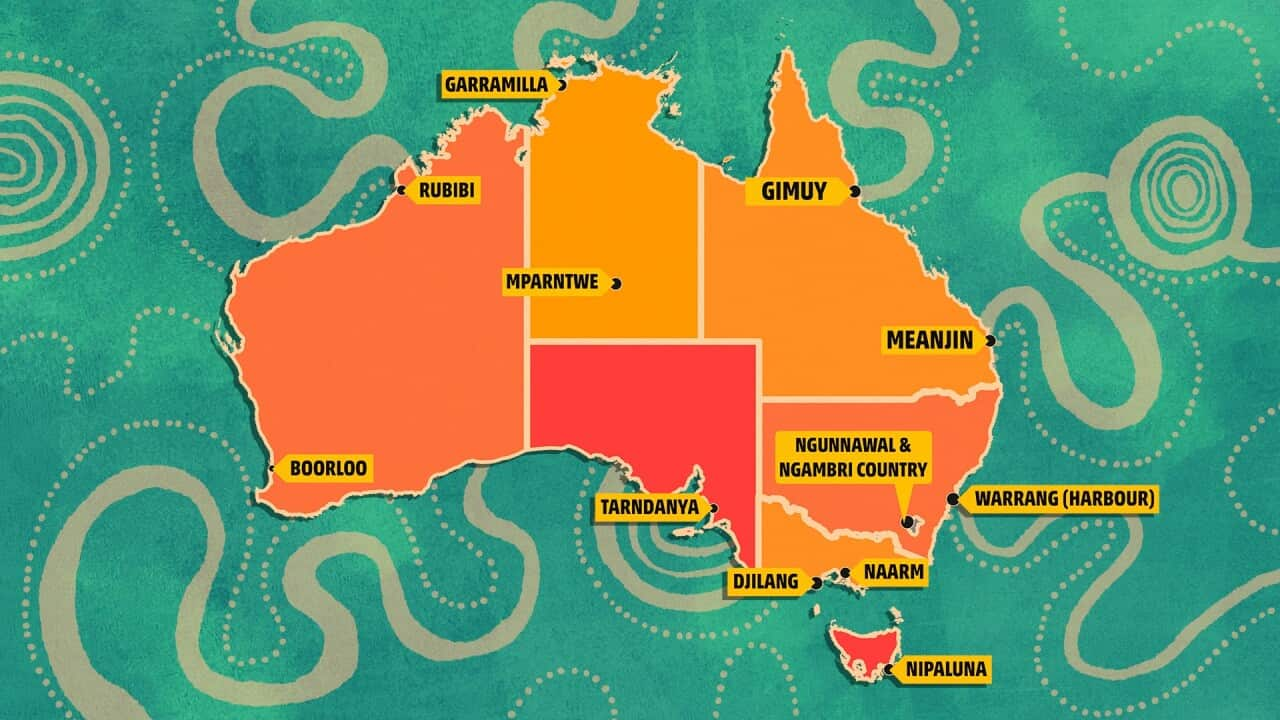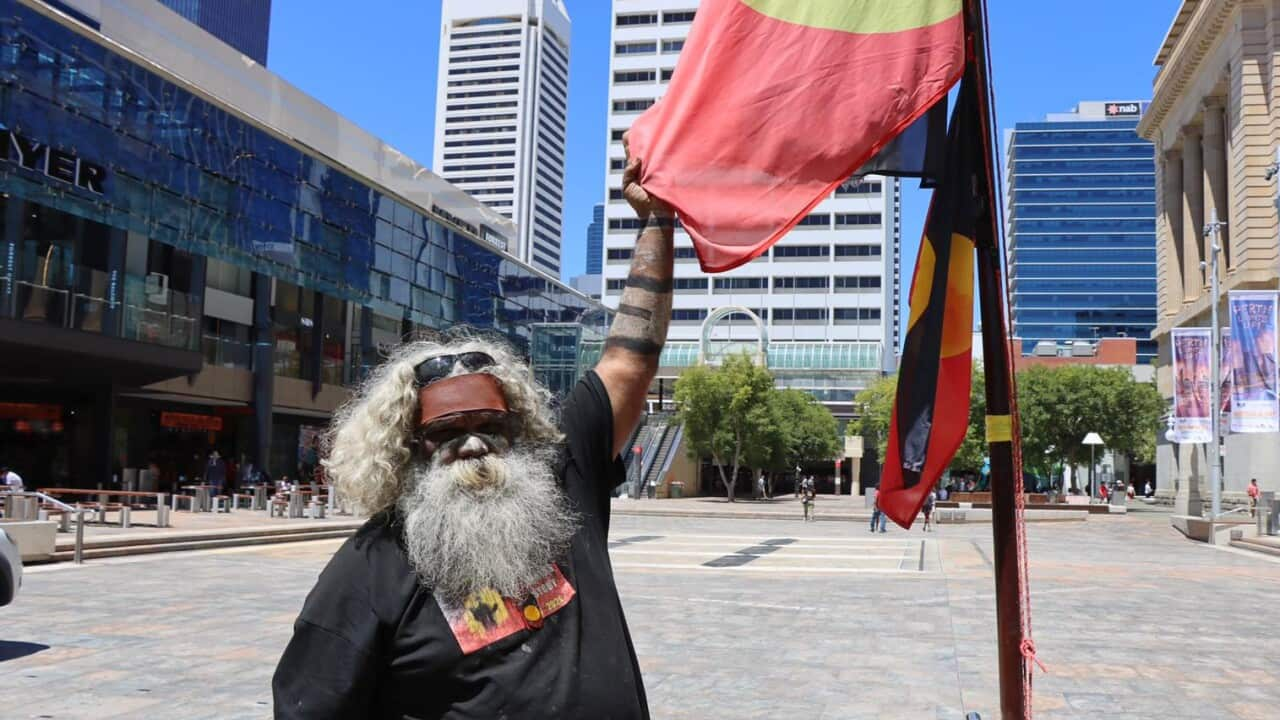January 26 is a for many First Nations people. It's a reminder of the unceded sovereignty over our lands.
That's because place defines us. It influences where we live or what language we speak.
But it's also more than that.
It's belonging to the land and listening to her stories.
It's knowing when the wet season arrives in the Top End or what time of year the wattle booms down south.
These lands are old and our cultures are enduring.
It was only 120-odd years ago, in 1901, that the British colonies here became Federated into eight states and territories.
But within these districts, the long-running sovereignty of First Nations remains, divided into over 250 clan groups.
Please note: Aboriginal and Torres Strait Islander languages are oral. These are the spellings that SBS, NITV & Traditional Owners agreed upon after extensive community consultation. Alternative spellings for these place names exist. For more information on Aboriginal geography, go to the .
Sydney Harbour - Warrang
Groups: Gadigal, Dharug, Dharawal and more
Sydney is a large area, comprised of many clan groups.
Some of the groups of the Sydney Harbour include the Gadigal, Cammaraygal and Bidjigal clans.
In the west, from approximately Parramatta to the Blue Mountains, consists the groups of the Dharug, Burramattagal and Cabrogal peoples.
There's also Dharawal country, which largely lies across the Illawarra region and into southern Sydney suburbs.
Adelaide - Tarndanya
Groups: Kaurna
Connected to the Red Kangaroo Dreaming, Tarndanya refers to the location south of the Karrawirra Parri (Torrens River) covering what is now the site of Adelaide city. The Kaurna word directly translates as 'male red kangaroo rock', referring to an original rock formation on the site (sadly, now destroyed).
Kaurna is pronounced Gaa-Na.

Protests at Parliament House, Adelaide on January 26. (Facebook/Gemma Weedall) Source: Facebook/Gemma Weedall
Like many Indigenous languages, Kaurna was at the threat of extinction for most of the 19th & 20th Centuries. In the 1980s, Kaurna Elders set about a revival of their language, assisted by a precious document — some-3,000 language words recorded by German missionaries in the 1800s. Since then, there's been a generous effort to , with Kaurna Linguistics courses available at The University of Adelaide, Year 11 & 12 language courses and Adelaide city council showcases across the metro region.
Alice Springs - Mparntwe
Groups: Eastern Arrernte, Central Western Arrernte
Mparntwe is Arrernte for 'Watering Place'. It refers to the waterhole in the Todd River located at the Old Telegraph Station on the northside of town. The place name, Mparntwe covers the majority of the Alice Springs township, with two other estates/place names, Irlpme over the south and Antulye on the east.
Mparntwe is pronounced M'bun-twa. Western Arrernte pronounces their name Arrunda and Eastern Arrernte say A'run-ta.
Eastern Arrernte Traditional Owners, the Laughton family, share that the mountainous MacDonell Ranges represent a chain of caterpillars (Yeperenye's), one of the main creation stories of Mparntwe. The main range overlooking the town, Mount Gillen is the tail of one of the caterpillars and its head slides into Heavitree Gap.
Brisbane - Meanjin
Groups: Turrbal, Yuggera and Yugambeh
Meanjin is a Turrbal (sometimes spelled Turrubul) word for the area where Brisbane's central city was established on Turrbal Country.

Protesters march through central Brisbane to protest Invasion Day. Source: AAP
The library states Yuggera (sometimes spelled Jagara), on the other hand, covers Ipswich, Lockyer, Boonah, Brisbane Valley, Brisbane Western Suburbs, parts of Greater Brisbane, Esk, Fassifern Valley and Gatton.
To the south, the Yugambeh "language region" of South East Queensland includes landscape within the City of Gold Coast, City of Logan, Scenic Rim Regional Council and the Tweed River Valley.
Canberra
Groups: Ngunnawal, Ngambri and Ngarigo

Ngunnawal Elder Serena Williams performs a smoking ceremony ahead of a Super Rugby Round, Canberra 2019. Source: Getty Images AsiaPac
There are two clan groups with ties to the Canberra region, the Ngunnawal (pronounced Nun-a-wol) and Ngambri (pronounced Ngam-bree).
The Ngarigo people of the Monaro region, also have ties to Canberra's far-south suburbs.
According to Ngunnawal Elder Wally Bell, Ngunnawal Country lies between Numeralla in the South, Crookwell in the North, the Brindabella Ranges in the West, and the escarpment near Braidwood in the West.
Ngunnawal/Ngambri Custodian, Paul House says Ngambri Country lies south-west of Weereewa (Lake George) within the surrounding rivers: Goodradigbee in the West, Murrumbidgee in the South and Yass in the East.
Ngunnawal Custodian Adrian Brown shares that the Murrumbidgee River, which flows through the ACT, means 'ceremony for men' in Ngunnawal.
'Murrum' means 'Pathway' and Bidgee means 'Boss'. Still today, Ngunnawal men will practice ceremony on the banks of the river, traversing upstream toward Mount Kosciuszko as they receive their Totems and corresponding land management responsibilities.
Darwin - Garramilla
Groups:

An aerial view of Darwin in the Northern Territory. Source: Getty Images
Larrakia Country runs from the Cox peninsula in the west, to Gunn Point in the north, and the Adelaide River in the east, down to the Manton Dam area southwards.
As Saltwater mob, the Larrakia People have strong connections to the sea and have a long history of voyage and trade with neighbouring groups such as Tiwi, Wagait and Wulna.
Larrakia protocols by three key totems: the boetdoemba (sea eagle), danggalaba (saltwater crocodile) and malama guligi (king brown snake). These three 'bosses' embody the air, sea and land and represent the key principles for the Larrakia in response to caring for Country: wisdom, guidance and respect.
Hobart - nipaluna
Groups: palawa people
that nipaluna was the name used by the original inhabitants of the Hobart region, the muwinina people (to whom we pay our respects as according to the Tasmanian Aboriginal Centre, none are surviving today), and refers to this sprawl of Country.
nipaluna is pronounced nee-pah-lu-nah and palawa is pah-lah-wah. The 'u' is pronounced as in 'put'.
The palawa people are the Tasmanian Aboriginal community of lutruwita (Tasmania). palawa kani is the revived language of the Tasmanian Aboriginal people.
To mark 2019 International Year of Indigenous languages, the Tasmanian Aboriginal Centre developed of the Aboriginal place names of over 200 places in lutruwita.
Melbourne - Naarm
Groups: Kulin Nation
that what is now the deep, wet Port Phillip Bay was once a large flat grassy plain. This area was known as Naarm, and it was a vast hunting ground for the local Kulin mob until ocean flood formed today's body of water.

An Invasion Day march on Naarm Country. Source: Supplied
Boon Wurrung Elder Aunty Carolyn Briggs of the great flood; of a time when the Kulin Nations were in conflict and neglected the land. This made the sea angry and begin to rise, taking away the peoples' Country as punishment and thus creating a body of water on top of their precious hunting ground, Naarm.
Perth - Boorloo
Groups: Whadjuk (Noongar Peoples)
Historian 'Boorloo' as a place name in the Moroo territory, one of four territories of the Whadjak peoples. north of the 'Derbarl Yerrigan' (Swan River), across the Perth CBD and the north-west suburbs.
Whadjuk nation is a part of the Noongar peoples collective, a network of 13 or so similar linguistic groups covering south-west Western Australia.
Boorloo is pronounced Boo-rr-loo and Whadjuk is Wad-jack.
'Wagual' is a central creation story for the Noongar people, known as a serpent-like spirit that created the Swan and Canning Rivers. Wagual's home to at the Derbarl Yerrigan bend near Success Hill where they continue to maintain a fresh water source for people and animals.
Interestingly, the word 'Quokka' — the big-cheeked marsupial found on Wadjemup (Rottnest Island) — is a Whadjuk word.
Sunset Ceremony premieres on NITV and SBS at 7:30pm on 25 January. You can also watch it later on SBS On Demand.
Join the conversation #AlwaysWasAlwaysWillBe
















